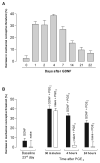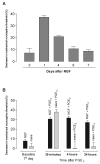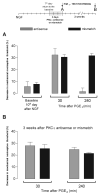Nociceptor subpopulations involved in hyperalgesic priming
- PMID: 19931357
- PMCID: PMC2815163
- DOI: 10.1016/j.neuroscience.2009.11.029
Nociceptor subpopulations involved in hyperalgesic priming
Abstract
We have previously developed a model in the rat for the transition from acute to chronic pain, hyperalgesic priming, in which a long-lasting neuroplastic change in signaling pathways mediates a prolongation of proinflammatory cytokine-induced nociceptor sensitization and mechanical hyperalgesia, induced at the site of a previous inflammatory insult. Induction of priming is mediated by activation of protein kinase C(epsilon) (PKC(epsilon)) in the peripheral terminal of the primary afferent nociceptor. Given that hyperalgesic mediator-induced PKC(epsilon) translocation occurs in isolectin B4 (IB4)(+)-nonpeptidergic but not in receptor tyrosine kinase (TrkA)(+)-peptidergic nociceptors, we tested the hypothesis that hyperalgesic priming was restricted to the IB4(+) subpopulation of nociceptors. After recovery from nerve growth factor (NGF)- and GDNF-induced hyperalgesia, a proinflammatory cytokine, prostaglandin E(2) (PGE(2)) induced, PKC(epsilon)-dependent, markedly prolonged hyperalgesia, two features that define the development of the primed state. Thus, hyperalgesic priming occurs in both the IB4(+)-nonpeptidergic and TrkA(+)-peptidergic subpopulations of nociceptive afferents. Of note, however, while attenuation of PKC(epsilon) prevented NGF-induced priming, the hyperalgesia induced by NGF is PKC(epsilon) independent. We propose that separate intracellular pools of PKC(epsilon), in the peripheral terminals of nociceptors, mediate nociceptor sensitization and the induction of hyperalgesic priming.
Copyright 2010 IBRO. Published by Elsevier Ltd. All rights reserved.
Figures




Similar articles
-
Hyperalgesic priming is restricted to isolectin B4-positive nociceptors.Neuroscience. 2010 Aug 11;169(1):431-5. doi: 10.1016/j.neuroscience.2010.04.082. Epub 2010 May 10. Neuroscience. 2010. PMID: 20457222 Free PMC article.
-
Opioid-Induced Hyperalgesic Priming in Single Nociceptors.J Neurosci. 2021 Jan 6;41(1):31-46. doi: 10.1523/JNEUROSCI.2160-20.2020. Epub 2020 Nov 17. J Neurosci. 2021. PMID: 33203743 Free PMC article.
-
Role of Nociceptor Toll-like Receptor 4 (TLR4) in Opioid-Induced Hyperalgesia and Hyperalgesic Priming.J Neurosci. 2019 Aug 14;39(33):6414-6424. doi: 10.1523/JNEUROSCI.0966-19.2019. Epub 2019 Jun 17. J Neurosci. 2019. PMID: 31209174 Free PMC article.
-
Roles of Proton-Sensing Receptors in the Transition from Acute to Chronic Pain.J Dent Res. 2016 Feb;95(2):135-42. doi: 10.1177/0022034515618382. Epub 2015 Nov 23. J Dent Res. 2016. PMID: 26597969 Review.
-
Critical role of nociceptor plasticity in chronic pain.Trends Neurosci. 2009 Dec;32(12):611-8. doi: 10.1016/j.tins.2009.07.007. Epub 2009 Sep 24. Trends Neurosci. 2009. PMID: 19781793 Free PMC article. Review.
Cited by
-
TRPV1, but not TRPA1, in primary sensory neurons contributes to cutaneous incision-mediated hypersensitivity.Mol Pain. 2013 Mar 4;9:9. doi: 10.1186/1744-8069-9-9. Mol Pain. 2013. PMID: 23497345 Free PMC article.
-
Plasma membrane mechanisms in a preclinical rat model of chronic pain.J Pain. 2015 Jan;16(1):60-6. doi: 10.1016/j.jpain.2014.10.007. Epub 2014 Nov 4. J Pain. 2015. PMID: 25451625 Free PMC article.
-
Contribution of Piezo2 to endothelium-dependent pain.Mol Pain. 2015 Oct 24;11:65. doi: 10.1186/s12990-015-0068-4. Mol Pain. 2015. PMID: 26497944 Free PMC article.
-
Sensory Neurons, Neuroimmunity, and Pain Modulation by Sex Hormones.Endocrinology. 2021 Aug 1;162(8):bqab109. doi: 10.1210/endocr/bqab109. Endocrinology. 2021. PMID: 34049389 Free PMC article. Review.
-
Second messengers mediating the expression of neuroplasticity in a model of chronic pain in the rat.J Pain. 2014 Mar;15(3):312-20. doi: 10.1016/j.jpain.2013.12.005. Epub 2014 Jan 7. J Pain. 2014. PMID: 24407022 Free PMC article.
References
-
- Amaya F, Shimosato G, Nagano M, Ueda M, Hashimoto S, Tanaka Y, Suzuki H, Tanaka M. NGF and GDNF differentially regulate TRPV1 expression that contributes to development of inflammatory thermal hyperalgesia. Eur J Neurosci. 2004;20:2303–2310. - PubMed
-
- Bennett DL. Neurotrophic factors: important regulators of nociceptive function. Neuroscientist. 2001;7:13–17. - PubMed
Publication types
MeSH terms
Substances
Grants and funding
LinkOut - more resources
Full Text Sources

